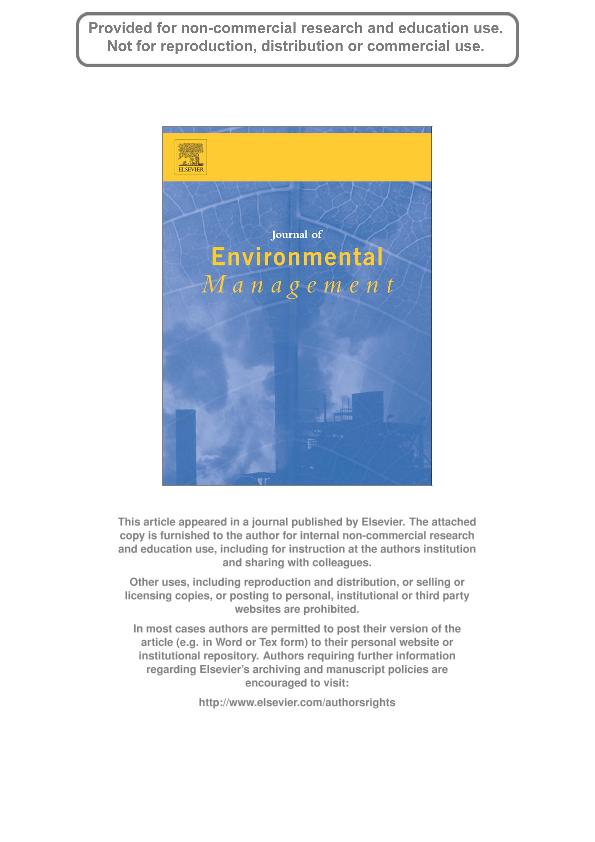Artículo
Sustainability of a constructed wetland faced with a depredation event
Maine, Maria Alejandra ; Hadad, Hernán Ricardo
; Hadad, Hernán Ricardo ; Sánchez, Gabriela Cristina; Mufarrege, María de Las Mercedes
; Sánchez, Gabriela Cristina; Mufarrege, María de Las Mercedes ; Di Luca, Gisela Alfonsina
; Di Luca, Gisela Alfonsina ; Caffaratti, Sandra Ester; Pedro, María del Carmen
; Caffaratti, Sandra Ester; Pedro, María del Carmen
 ; Hadad, Hernán Ricardo
; Hadad, Hernán Ricardo ; Sánchez, Gabriela Cristina; Mufarrege, María de Las Mercedes
; Sánchez, Gabriela Cristina; Mufarrege, María de Las Mercedes ; Di Luca, Gisela Alfonsina
; Di Luca, Gisela Alfonsina ; Caffaratti, Sandra Ester; Pedro, María del Carmen
; Caffaratti, Sandra Ester; Pedro, María del Carmen
Fecha de publicación:
10/2013
Editorial:
Elsevier
Revista:
Journal of Environmental Management
ISSN:
0301-4797
Idioma:
Inglés
Tipo de recurso:
Artículo publicado
Clasificación temática:
Resumen
A free water surface constructed wetland (CW) designed for effluent treatment was dominated by the emergent macrophyte Typha domingensis reaching a cover of roughly 80% for 5 years. Highly efficient metal and nutrient removal was reported during this period. In June 2009, a population of approximately 30 capybaras (Hydrochoerus hydrochaeris) caused the complete depredation of the aerial parts of macrophytes. However, plant roots and rhizomes were not damaged. After depredation stopped, T. domingensis showed a luxuriant growth, reaching a cover of 60% in 30 days. The objective of this work was to evaluate the sustainability of the CW subjected to an extreme event. Removal efficiency of the system was compared during normal operation, during the depredation event and over the subsequent recovery period. The CW efficiently retained contaminants during all the periods studied. However, the best efficiencies were registered during the normal operation period. There were no significant differences between the performances of the CW over the last two periods, except for BOD. The mean removal percentages during normal operation/depredation event/recovery period, were: 84.9/73.2/74.7% Cr; 66.7/ 48.0/51.2% Ni; 97.2/91.0/89.4% Fe; 50.0/46.8/49.5% Zn; 81.0/84.0/80.4% NO3 - ; 98.4/93.4/84.1% NO2 - ; 73.9/ 28.2/53.2% BOD and 75.4/40.9/44.6% COD. SRP and TP presented low removal efficiencies. Despite the anoxic conditions, contaminants were not released from sediment, accumulating in fractions that proved to be stable faced with changes in the operating conditions of the CW. T. domingensis showed an excellent growth response, consequently the period without aerial parts lasted a few months and the CW could recover its normal operation. Plants continued retaining contaminants in their roots and the sediment increased its retention capacity, balancing the operating capacity of the system. This was probably due to the fact that the CW had reached its maturity, with a complete root-rhizome development. These results demonstrated that faced with an incidental problem, this mature CW was capable of maintaining its efficiency and recovering its vegetation, demonstrating the robustness of these treatment systems.
Palabras clave:
Sediment
,
Contaminants
,
Effluent
,
Macrophytes
,
Capybaras
,
Constructed Wetlands
Archivos asociados
Licencia
Identificadores
Colecciones
Articulos(CCT - SANTA FE)
Articulos de CTRO.CIENTIFICO TECNOL.CONICET - SANTA FE
Articulos de CTRO.CIENTIFICO TECNOL.CONICET - SANTA FE
Citación
Maine, Maria Alejandra; Hadad, Hernán Ricardo; Sánchez, Gabriela Cristina; Mufarrege, María de Las Mercedes; Di Luca, Gisela Alfonsina; et al.; Sustainability of a constructed wetland faced with a depredation event; Elsevier; Journal of Environmental Management; 128; 10-2013; 1-6
Compartir
Altmétricas



